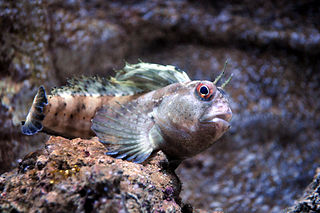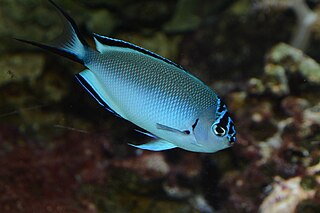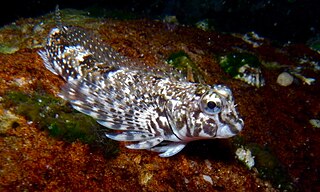
Combtooth blennies are blenniiformids; percomorph marine fish of the family Blenniidae, part of the order Blenniiformes. They are the largest family of blennies with around 401 known species in 58 genera. Combtooth blennies are found in tropical and subtropical waters in the Atlantic, Pacific and Indian Oceans; some species are also found in brackish and even freshwater environments.

The tompot blenny is a species of combtooth blenny from the north eastern Atlantic Ocean which is found in shallow, coastal waters off western Europe, the Mediterranean and North Africa.

Genicanthus watanabei, the blackedged angelfish or Watanabe’s angelfish, is a species of marine ray-finned fish, a marine angelfish belonging to the family Pomacanthidae. It is found in the Pacific Ocean.

The Brazilian snapper, is a species of snapper native to the tropical waters of the Atlantic off the coast of Brazil.

The sixbar angelfish, also known as the six banded angelfish, is a species of marine ray-finned fish, a marine angelfish belonging to the family Pomacanthidae. It is found in Indo-Pacific region.

The reticulate unicornfishes is a species of marine ray-finned fish belonging to the family Acanthuridae, the surgeonfishes, unicornfishes and tangs. It is a rare species found on coral reefs in the Indo-West Pacific region.

The Pacific leaping blenny, also known as the leaping rockskipper, is a species of combtooth blenny in the genus Alticus. The blennies are oviparous, and form distinct pairs when mating. Males can reach a maximum total length of 8 centimetres. These fish feed primarily on benthic algae, which they consume by scraping off rocky surfaces.

Hypleurochilus is a genus of combtooth blennies found throughout the Atlantic Ocean.
Hypleurochilus langi is a species of combtooth blenny found in the eastern Atlantic ocean, from Senegal to the mouth of the Congo River. This species grows to a length of 7 centimetres (2.8 in) SL. This blenny is euryhaline and it enters mouths of large rivers and occurs among mangroves, it prefers brackish water. The specific name of this blenny honours the German zoologist and taxidermist Herbert Lang (1879-1957) of the American Museum of Natural History, who helped to collect the type.

Hypleurochilus springeri, the orange-spotted blenny, is a species of combtooth blenny found in coral reefs in the Caribbean Sea. This species grows to a length of 5 centimetres (2.0 in) TL. The specific name honours the American ichthyologist Victor G. Springer.

Hypsoblennius invemar, commonly known as the tessellated blenny, is a species of combtooth blenny found in the western Atlantic Ocean.

Istiblennius dussumieri, the streaky rockskipper, is a species of combtooth blenny found in coral reefs in the western Pacific and Indian Oceans. It is also commonly known as the Dussumier's rockskipper, streaky dussumier, or the Dussumier's blenny.
Ophioblennius trinitatis is a species of combtooth blenny endemic to the southwest Atlantic ocean. It is a subtropical marine fish commonly found in reefs off the coast of Brazil. Combtooth blennies are often referred to as "peixes-macacos" in Brazil, which translates to "monkey-fish".
Scartella poiti is a species of combtooth blenny found in coral reefs in the southwest Atlantic ocean, around Trindade Island, Brazil. This species reaches a length of 8.5 centimetres (3.3 in) SL. The specific name honours the Brazilian Navy's Posto Oceanográfico da Ilha da Trindade, in gratitude for their assistance to the authors on their trips to the island.

Stanulus talboti, Talbot's blenny, is a species of combtooth blenny found in coral reefs in the western Pacific Ocean. This species feeds primarily on plants, including benthic algae and weeds. This species can reach 4.8 cm (1.9 in) in TL. This fish is also found in the aquarium trade.
Xiphasia matsubarai, the Japanese snake blenny, is a species of combtooth blenny found in the western Pacific and Indian oceans just extending into the Atlantic Ocean in False Bay, South Africa. This species can be found at depths ranging from the surface to 4,960 m (16,270 ft). This species reaches 30 cm (12 in) in SL. This species feeds primarily on bony fish, rising to the surface at night to feed. It can also be found in the aquarium trade.

The eastern jumping blenny is a species of triplefin blenny in the genus Lepidoblennius. It was described by Franz Steindachner in 1867 and is the type species of the genus Lepidoblennius.

Chaetodon guentheri, Günther's butterflyfish or the crochet butterflyfish, is a species of marine ray-finned fish, a butterflyfish belonging to the family Chaetodontidae. It is native to The western Pacific Ocean.

Genicanthus melanospilos, the spotbreast angelfish, blackspot angelfish or swallowtail angelfish, the family Pomacanthidae. It occurs in the Indo-West Pacific region.
Cirripectes heemstraorum, the yellowtail blenny, is a species of combtooth blenny from the family Blenniidae. It is found in the Indian Ocean where it is known from three South African specimens and an Indonesian specimen. It is distinguished from its congeners by the nape having an extensive black flap on both sides of its neck; 10-13 cirri which are found between the neck flaps; an entire dorsal fin; 5-6 cirri above the eye, 6-8 cirri on the nose; the males have small dark spots on their body towards the tail which merge to form short black stripes on caudal peduncle, in life the females have a brilliant yellow caudal fin while in the males only the outer half of the tail is bright yellow.














